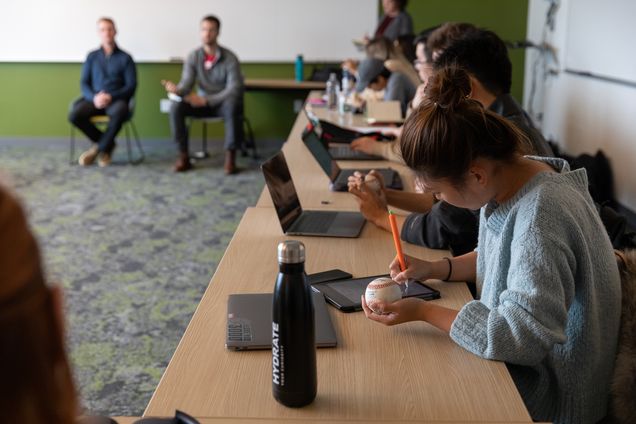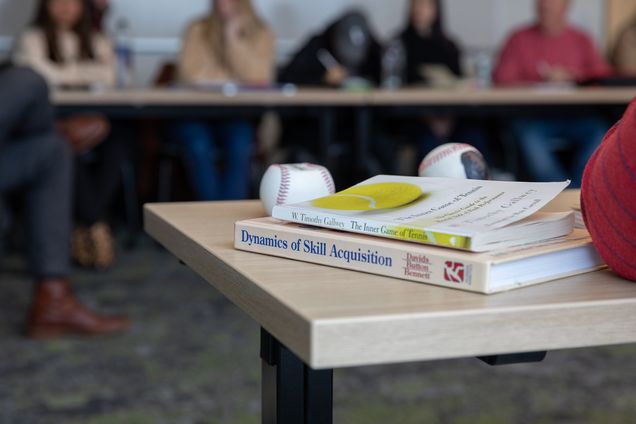XCC Class Goes to the Bullpen to Finish the Semester
March 30, 2020
By Devyani Chhetri

It’s a time of virtual interactions, time differences and uncertainty.
As the global pandemic brings with it mounting challenges, students, faculty and staff of BU have started finding ways to innovate and cope. Amid this flux, we sat down for an interview via Zoom with Prof. Andy Andres of the College of General Studies (CGS) who teaches the XCC course “Making of a great baseball player” with Clinical Assistant Professor Kathryn Webster.
Andres was optimistic and undeterred by the upturn caused by the outbreak. “We thankfully did a lot of content based work before spring break. We formed project groups, got students thinking about questions,” he said. “The last half of the semester is going to be about refining these questions and present it well.”
The class peels apart the technologies and strategies employed by Major League Baseball teams. The style of a pitcher in generating the right velocity as he spins to launch the ball, the best practices to avoid injury and the cognitive science behind reaction times are a few of many questions pitched during the classes.
“For our class we’re lucky that most of our projects are front loaded on content,” he said. “We only have two sessions left and Zoom can do that.”
“Obviously the sharing of content on Zoom is inferior to sharing the content in class,” he added. “There is more interaction in class. But that’s a small compromise that we’ve had to make.”
Andres and Webster, much like other XCC professors, are recording every session to ensure that students in the country and abroad can catch up with all classes despite the time difference or logistics. “I’m confident that Kathryn and I will be able to guide them in the next couple of months,” Andres said.

Andres has had a long career as a researcher and educator. The son of an Air Force officer, Andres spent the tentative years of his life moving. “We moved all over. I spent the first 10 years of my life in 10 different locations,” he said. After settling in New Jersey for his junior high and high school, Andres would later go to college at Brown in Providence.
He became a computer programmer. During this period, he programmed code, wrote c-compliance for four years and then later went back to grad school. But he decided against taking the circuitous route of computer science and ended up majoring in biology at Harvard School of Public Health. He then went to Tufts to finish his PhD and postdoc at Tufts. After a long journey, he made his way to BU to teach.
“I think I fell into education mainly because it sort of suits my abilities,” he said when asked if he always wanted to teach.
“I feel comfortable talking in front of crowds and I’m a quick learner–– that’s something that’s been true all my life,” he said. “I was always a more studious, nerdy kind of a kid. When I went to grad school, my mentors pushed me to teach. Ultimately I kind of stuck around.”
During the birthing stages of XCC, Andres had a hard time thinking of how to best design the course. Things became clearer after he teamed up with Kathryn Webster.
“Kathryn’s such a terrific partner,” he said. “She’s so good with athletic training, injury rehabilitation, injury prevention and she has her own particular interest in baseball. Meanwhile, I was coming from the data science side,” he said.
Hence began a partnership for a baseball course. “We kind of went back and forth. Kathryn and I decided that the modern technology employed in the game could be a framework for students to think,” he said.
The ideas and passion that the students brought with them to class is one that he hadn’t expected. “We did an introductory survey to see what their [students] majors were and what their interests and why they’re studying baseball,” he said. “After seeing these 25 students and how passionate they were about the game, how willing they were to engage, I thought to myself–– great! it was going to work out!”
His favorite moments in the classroom were the ones where students interacted with guest speakers.
“The students had the chance to speak with the author of MVP Machine, Ben Lindbergh, after having read the book,” he said. The MVP Machine, which is part of the syllabus, is in line with Andres’ and Webster’s course that studies how statistical analysis can quite literally change the face of the game.
“We also had two scouts, Carlos Munoz, associate scout for the Cincinnati Reds and Kimball Crossley for the Toronto Blue Jays come in. They were so knowledgeable and broke down the game really well for the students,” he said.
“The two guest sessions were home runs,” he said with a smile.
Andres credited a lot of the course’s smooth sailing to the collaboration between him and Webster. “Normally as a university faculty, you’re on your own and you teach your own class,” he said.
“You have your graders, teaching assistants that help you. But it’s just you and you’re kind of incharge.”
There have been instances of occasional bouts of team teaching and team research, he said. But this was co-teaching and it required a collaboration that he hadn’t done in a while.
“I wouldn’t say it’s been 100% easy. We’ve disagreed here and there. But I’ve learned so much from her,” he remarked. “I’ve also learned to take a step back a bit and trust that we’re both on the same page.” To him that was fundamental because of how it impacted student learning.
As the interview neared its end, there was time for one last important question.
If Andres was an XCC student, which course would he pick to study apart from baseball? “Always baseball,” he said with a laugh.
“My nature is more quant-scientific so the BU Spark course fits my interests, I think,” he said. “But I know that all five, including mine, are supposed to push people beyond their comfort zone so I can see myself joining all of them.”
However, as a baseball fan and now the teacher of course that dives deep into what he loved, he was quick to add. “But remember, the first and foremost, is always baseball.”

This article was written by Devyani Chhetri, a graduate assistant with XCC.